Article and photos:Nguyen Chi Linh
My friend Karen, a British teacher, and I decided to buy a tour from the capital Ulaanbaatar to go into the Gobi desert by Jeep to live the nomadic life of the ancient Mongolians. Accompanying us was our guide Gana and driver Burmaa. Gana spent about an hour shopping for food from the supermarket to prepare for the trip.
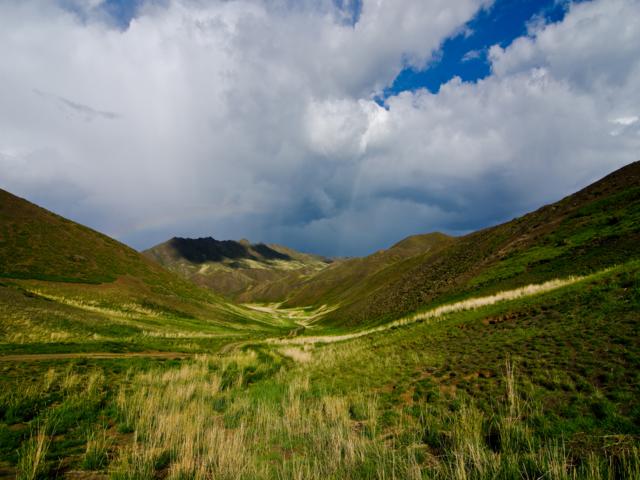
The amazing "Grand Canyons" in the ancient desert
Gana kept asking us if we knew about Genghis Khan. To her and the Mongols, he was a great hero and the father of the nation. All banknotes bore his image as a sign of respect. Gana said that the Gobi desert had nurtured Genghis Khan's proud hooves to gallop across different lands on his way to conquer Asia and Europe.
The Gobi Desert is one of the five largest deserts in the world and the largest desert in Asia. Stretching from north to south about 800km and from southwest to northeast about 1,600km, the Gobi is one of the coldest deserts in the world. In winter, the desert is often covered in a thick, mysterious fog and the mountain peaks are often covered in white snow. Temperatures sometimes drop to about -30 degrees. In summer, the climate is warmer. What makes the Gobi different from other deserts is that the temperature can change rapidly in one day, creating many different seasons, according to Ms. Gana.
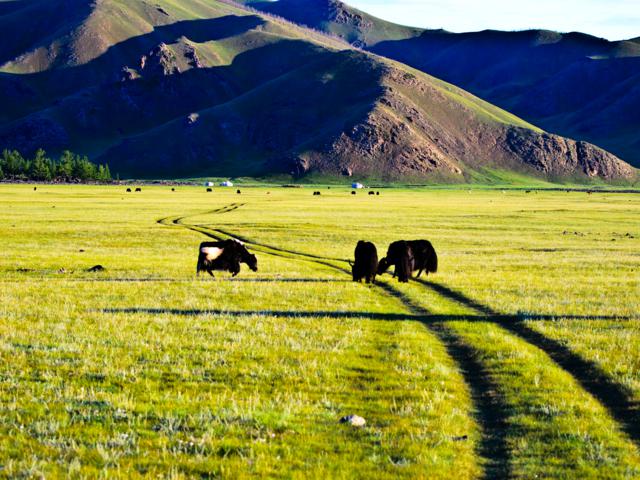
The sky was cloudless like a giant blue silk stretched across, the sun shining with warm rays that lessened the cold from the desert winds. We stopped by the city of Erdenedalai after a day of traveling from the capital Ulaanbaatar. Erdenedalai is a city located in the south of Mongolia and is the gateway to the Gobi Desert. It is a land of mixed vast grasslands and wild desert. Gana took us to see the rocks that rose from the desert and were cut into many different shapes, especially the rocks shaped like eggs.
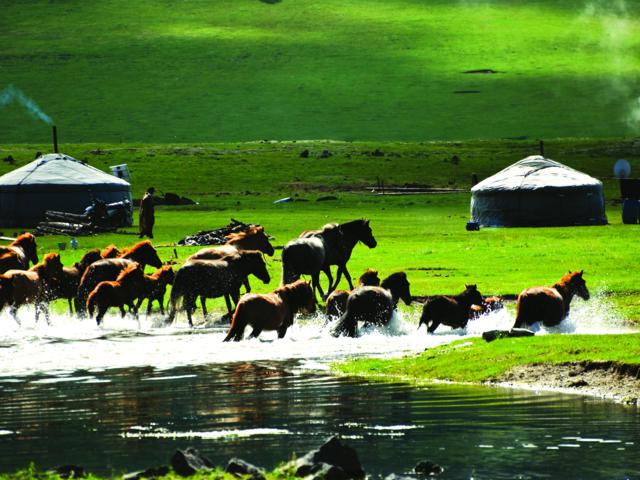
I looked at the protruding rocks and silently compared those sandstones to children born from poor families because they were not as beautiful and famous as Cappadocia in Türkiye or the Grand Canyon in the United States. But no, it was still beautiful and beautiful in the simple, honest way of the Mongolians. It still sang the days with the sweet grasslands around it and on those grasslands still echoed the hooves of the great Genghis Khan on the roads of conquest.
People say that rocks are inanimate objects, without souls. But no, in the Gobi desert, they suddenly become souls following the intersection of darkness and light.
Volcanic activity not only provides humans with a large amount of fertile basalt soil for farming and cultivation, but also leaves behind a fascinating natural landscape. People often use the word “hoodoo” to refer to the rocks of different shapes formed by volcanic activity in deserts or hot and dry regions.

Hoodoos are typically tall boulders that range from about as tall as a human head to as tall as a 10-story building. Hoodoos often have thin spirals at the top. The tops of hoodoos are typically made of hard sedimentary rock and are less susceptible to erosion, so hoodoos remain firmly in place over time.
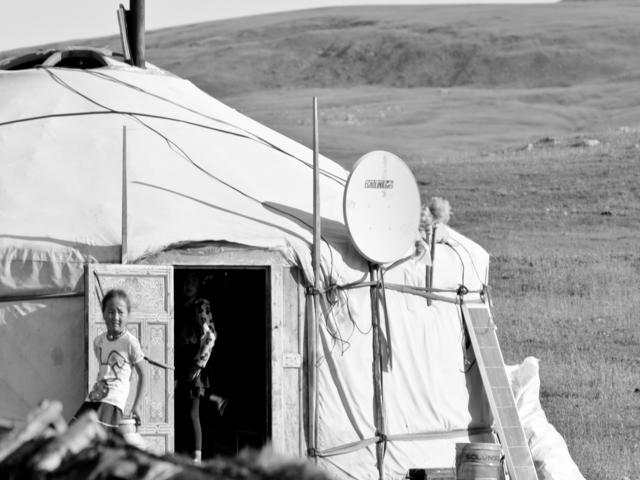
Geological studies have also shown that the hoodoos are usually made up of a thick layer of volcanic rock (this layer of rock is formed by volcanic ash sticking together); the outside of this rock layer is covered by a thin layer of basalt or other layers of volcanic dust. It is the red basalt layer or the layer of volcanic dust that helps the hoodoos to be less eroded by time and other factors such as rain, wind, light, temperature, etc. Because it is formed by volcanic activity, the hoodoos contain a lot of minerals. It is these minerals that make the hoodoos have many different colors according to the sunlight and this color depends a lot on the height of the hoodoos.
The following days, Gana took us deep into the desert in the Tsagaansuvarga, Bagagazariinchuluu or Bayanzag regions where the hoodoos were formed. Karen and I were extremely excited to see and wander around the hoodoos in different shapes: young bamboo shoots, mushrooms, chimneys of fairy tale castles or sitting figures... They had different colors in the sunset or when dawn came. My fascination was so great that I forgot the cold winds at sunset or dawn suddenly hitting the steep cliffs.
Then on those high mountains, a few small wells were formed inside the rocks. Gana called it Holy Water and drew some for us to try. According to the local belief, drinking or washing the eyes with Holy Water helps people live longer and have a clearer mind.
Experience life in the desert wilderness
Driver Burmaa kept steering smoothly as the car sped through the vast desert. What always made Karen and I wonder was how he could easily find his way when there were no traffic signs among the grasslands or wild sand dunes. Mr. Burmaa said that for people who lived long in the desert, they found their way by following the direction of the sun and the stars in the sky. Mr. Burmaa found his way by looking at the shapes of the mountains and the Mongolian spiritual temples made of stone on the high mountains. Just by looking at and following the stone temples, he would know there would be a village or town nearby.

We stayed overnight in traditional Mongolian tents called Yurts. The white tents look very simple on the outside but are colorfully designed and quite beautiful on the inside. Most of the activities, meals… take place in the main tent of the host, the other tents are only for overnight guests. Inside the Yurt is divided into 2 parts, on the left is a bed with a small table for the head of the family, on the right is a bed with a kitchen for the hostess. Connecting the space between the 2 areas of men and women is an altar for ancestors and spiritual religion. In front of the altar is a small table for common activities such as eating rice or drinking tea. The stove with a large chimney is located right at the entrance for daily cooking, and also acts as a fireplace in the winter.
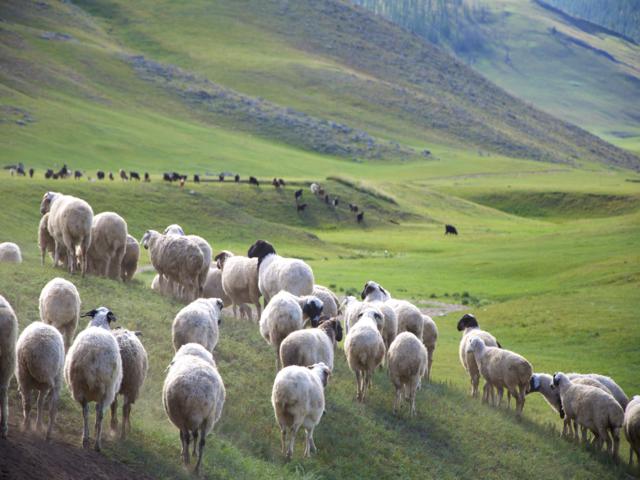
Every afternoon, if we weren’t reading, Karen and I would join our host family in shearing camels and sheep. Bataar, the host family in the Tsagaansuvarga area, shared that water and electricity are two important factors and almost the source of life for a self-sufficient lifestyle in the desert. The traditional occupation of the local people is raising cattle on the vast grasslands. When underground water sources are found, the nomadic life becomes settled.
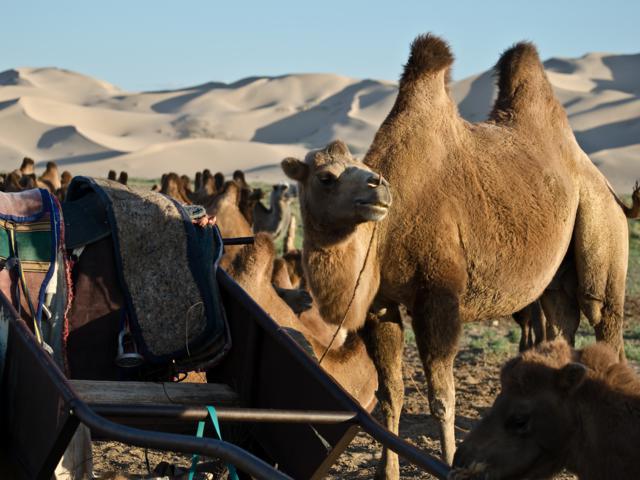
Camel hair is braided and stuffed into felt to form the domes and walls around the yurt. Wool is woven into warmer sweaters in winter, and dung is collected and dried for cooking and heating purposes during changing weather. Horses and camels transport water from underground aquifers to the yurt for storage. Wealthier families buy batteries to watch TV or light lamps for evening tea and conversation. Telephones are hung from the yurt domes to receive reception.

I also learned the Mongolian way of washing dishes super water-saving by using many towels after each rinse with clean water. Karen, who had more experience in the desert than me, brought along many useful items in the absence of water: wet tissues to wipe her face every morning or mouthwash made into a liquid gel or candles to read at night. Living in a condition lacking many things, I still felt happy because more importantly, I had the experience of the nomadic life of the Mongolians.
The happy days have passed. Living in conditions lacking many things, but I still feel happy because more importantly, I have had experiences about the nomadic life of the Mongols. And I think that it was that lifestyle that helped Genghis Khan's horses to manage the situation on the way to conquer Asia - Europe in the past.
More information:
+ There are 2 airlines operating flights from Ho Chi Minh City or Hanoi to Ulaanbatar: Air China and Korean Air. Korean Air is a good choice because the transit time is only 12 hours compared to Air China's 22 hours.
+ The weather in Ulaanbatar is very harsh and changes suddenly, one day can have many seasons, so it is necessary to check the status of flights before departure.
+ Most tourists have to buy a tour to go to the Gobi desert. The tour price depends on the number of participants. The price ranges from 50 USD - 80 USD/person/day.
+ The currency of Mongolia is Tughrik (MNT). You can exchange money at local banks at the rate of 1 USD = 1.825MNT
+ The capital Ulaanbatar is not too big and the attractions are quite close together, visitors can walk to visit: Ganda Pagoda, Sukhbaatar Square, Zanabazar Art Museum, international museum, Bogd Kahn Summer Palace...


































